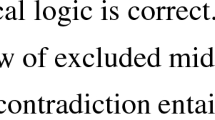Abstract
With each proposition P we associate a set of proposition (a hyperproposition) which determines the order in which one may retreat from accepting P, if one cannot fully hold on to P. We first describe the structure of hyperpropositions. Then we describe two operations on propositions, subtraction and merge, which can be modelled in terms of hyperpropositions. Subtraction is an operation that takes away part of the content of a proposition. Merge is an operation that determines the maximal consistent content of two propositions considered jointly. The merge operation gives rise to an inference relation which is, in a certain sense, optimally paraconsistent.
Similar content being viewed by others
REFERENCES
Da Costa, N. (1974): On the theory of inconsistent formalsystems, Notre Dame J. Formal Logic 15: 497–510.
Fuhrmann, A.(1997a): An Essay on Contraction, Stanford (CSLI).
Fuhrmann, A.(1997b): Solid belief, Theoria 63: 90–104.
Grove, A. (1988):Two modellings of theory change, J. Philos. Logic 17: 157–170.
Hansson, S. O. (1996): Non-prioritized belief change.
Hudson, J. L. (1975):Logical subtraction, Analysis 35: 130–135.
Humberstone, L. (1981):Logical subtraction: Problems and prospects, Melbourne (typescript).
Jaeger, H.(1973): Action and subtraction, Philos. Review 82: 320–329.
James, W. (1911): Lectures on Pragmatism, Longmans, Green, & Co., NewYork.
Jaśkowski, S. (1969): A propositional calculus for inconsistent deductivesystems (1948), Studia Logica 24: 147–157.
Lemmon, E. J. and D.S. Scott (1977): An Introduction to Modal Logic (The Lemmon Notes), ed. K. Segerberg, Blackwell, Oxford.
Lewis, D. K. (1973):Counterfactuals, Blackwell, Oxford.
Lewis, D. K. (1982): Logic forequivocators, Nous 16: 431–441.
Lindström, S. and W. Rabinowicz(1991): Epistemic entrenchment with incomparabilities and relational belief revision, in: A. Fuhrmann and M. Morreau (ed.), The Logic of Theory Change, Springer, Berlin-New York, pp. 93–126.
Priest, G. (1979): Logic ofParadox, J. Philos. Logic 8: 219–241.
Segerberg, K. (1995): Beliefrevision from the point of view of doxastic logic, Bull. IGPL 3: 535–553.
Segerberg, K. (1996): Further questions about hypertheories, in:S. Lindström et al. (eds.), Odds and Ends. Essays Dedicated to Wlodek Rabinowicz, Dept. of Philosophy, Uppsala, pp. 171–184.
Segerberg, K.(199+): Irrevocable belief revision in dynamic doxastic logic, Notre Dame J. Formal Logic, forthcoming.
Wittgenstein, L. (1953): PhilosophicalInvestigations, Blackwell, Oxford.
Author information
Authors and Affiliations
Rights and permissions
About this article
Cite this article
Fuhrmann, A. When Hyperpropositions Meet .... Journal of Philosophical Logic 28, 559–574 (1999). https://doi.org/10.1023/A:1004792327149
Issue Date:
DOI: https://doi.org/10.1023/A:1004792327149




